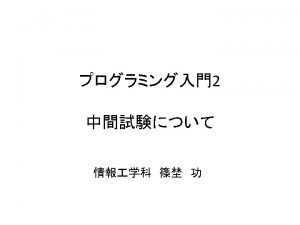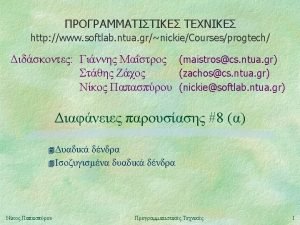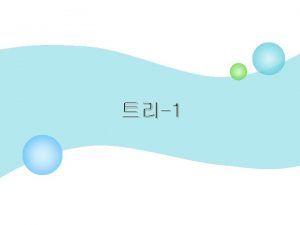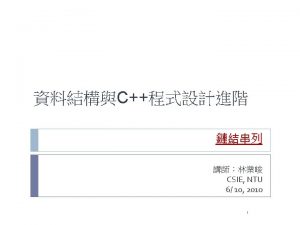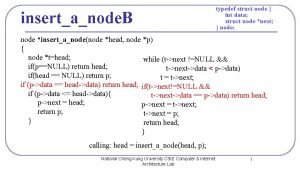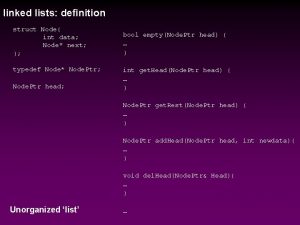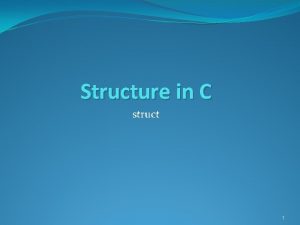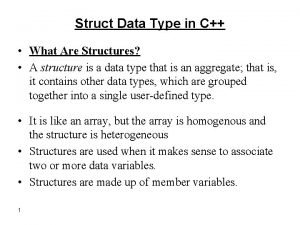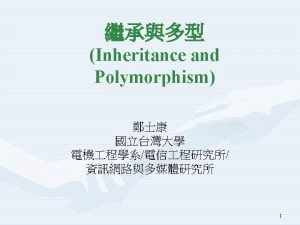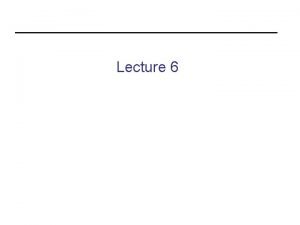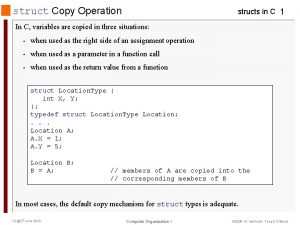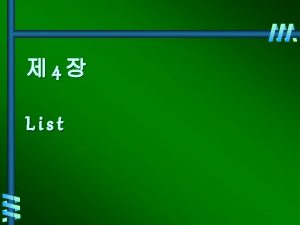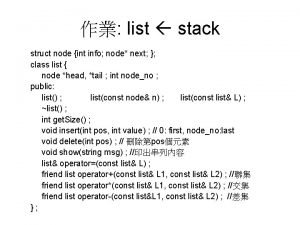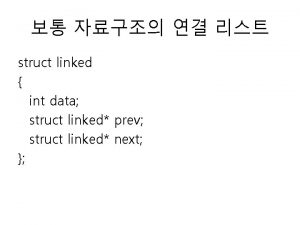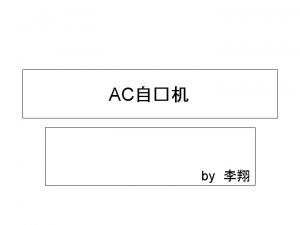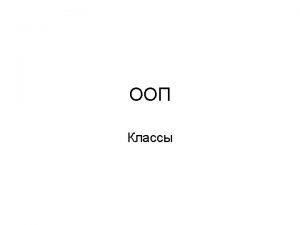Summary on linked lists Definition struct Node int



















- Slides: 19

Summary on linked lists Definition: struct Node{ int data; Node* next; }; typedef Node* Node. Ptr; Node. Ptr head; Head 20 45 75 85

bool list. Empty(Node. Ptr head) { return (head==NULL); } int get. Head(Node. Ptr head) { if (head != NULL) return head->data; else {cout << “Error” << endl; exit(1); }; } Node. Ptr next(Node. Ptr head) { Node. Ptr p=NULL; if (head != NULL) p=head->next; return p; } Node. Ptr add. Head(Node. Ptr head, int newdata) { // or: void add. Head(Node. Ptr& head, int newdata) { Node. Ptr new. Ptr = new Node; new. Ptr->data = newdata; new. Ptr->next = head; return new. Ptr; // or: head = new. Ptr; } Node. Ptr del. Head(Node. Ptr Head){ // or: void del. Head(Node. Ptr& head) if(head != NULL){ Node. Ptr cur = head; head = head->next; delete cur; } return head; // no return for ‘void del. Head()’ } (! list. Empty()) Operations on (unsorted) linked lists - list. Empty(l) - add. Head(l, data) - get. Head(l) - delete. Head(l) - get. Rest(l) - add. Head(l, a)

Towards an abstract data type, List typdef List Node. Ptr int data; List l; - list. Empty(l) add. Head(l, data) get. Head(l) delete. Head(l) next(l)

Some simple algorithms (applications) * Write a function that returns the length of a given list. * Write a boolean function that tests whether a given unsorted list of characters is a palindrome. * Write a function that computes the union of two sorted linked lists of integers.

The length of a given list: int length(Node. Ptr head) { Node. Ptr cur = head; int l=0; while(cur != NULL){ l++; cur = next(cur); } return l; int length(List list) { List cur = list; int length=0; while(!list. Empty(cur)){ l++; cur = next(cur); } return length; } }

Recursive version: int length(Node. Ptr head) { int l; if(head==NULL) l=0; else l=length(head->next)+1; return l; } Or in functions: int length(List head) { int l; if(list. Empty(head)) l=0; else l=length(next(head))+1; return l; } delete. Head

Everything is recursive with lists: recursively print a list: void print(Node. Ptr head) { if(head != NULL){ cout << head->data; print(head->next); } } Re-write in a bit higher level of abstraction: void print(List l) { if(!list. Empty(l)){ cout << get. Head(l); print(next(l)); } }

Test if the given list is a palindrome: [a b c d d c b a] is a palindrome, [a b c d c] is not. bool is. Palindrome(Node. Ptr head) { 1. create a new list in inverse order, new. List 2. check the two lists, head and new. List, whether they are the same }

Create a new list in the inverse order new. Head is the pointer to the new list! Node. Ptr new. Head=NULL; Node. Ptr p=Head; while(p != NULL) { add. Head(new. Head, p->data); // or: new. Head=add. Head(new. Head, p->data); p=p->next; }

Check wheter two lists are the same: Node. Ptr p 1 = head; Node. Ptr p 2 = new. List; bool palindrome=true; while((p 1 != NULL) && (palindrome) ){ if ((p 1 ->data)==(p 2 ->data)) { p 1=p 1 ->next; p 2=p 2 ->next; } else palindrome=false; } return palindrome;

bool is. Palindrome(Node. Ptr head) { Node. Ptr new. List=NULL; Node. Ptr p=head; while(p != NULL) { add. Head(new. List, p->data); p=p->next; } Create the new list Node. Ptr p 1=head; Node. Ptr p 2=new. List; bool palindrome=true; while((p 1 != NULL) && (palindrome) ){ if ((p 1 ->data)==(p 2 ->data)) { p 1=p 1 ->next; p 2=p 2 ->next; } else palindrome=false; } p=new. List; while (p!=NULL) { del. Head(p); } return palindrome; } Test the two lists Remove the new. List properly!

Do it recursively To do this, we need to use the functional definition of add. End: Node. Ptr add. End(Node. Ptr Head, int item) bool is. Palindrome(Node. Ptr head) { bool palin; Node. Ptr new. Head=reverse(head); palin=equal(head, new. Head); delete. List(new. Head); return palin; }

Node. Ptr reverse(Node. Ptr head) { Node. Ptr res; if (head==NULL) res=NULL; else res=add. End(reverse(head->next), head->data); return res; }

bool equal(Node. Ptr p 1, Node. Ptr p 2) { bool equality; if (p 1==NULL) equality = true; else if ((p 1 ->data)!=(p 2 ->data)) equality = false; else equality=palindrome(p 1 ->next, p 2 ->next); return equality; }

void delete. List(Node. Ptr head) { Node. Ptr p=head; if (p!=NULL) { p=delete. Head(p); delete. List(p); } }

Union of two lists: given two linked lists, create a new sorted list that is the union of the two. union ([1, 5, 4, 2], [3, 7, 5, 6, 4]) gives [1, 5, 4, 2, 3, 7, 6]

Node. Ptr union(Node. Ptr p 1, Node. Ptr p 2) { // look at the frist list p 1 while (p 1 is not empty) { just copy it! } // simply: union. List = p 1; // start from p 1 // look at the second list p 2 while(p 2 is not empty){ if the first element of p 2 is not in the current union, then add it into the union list otherwise, move forward the list } return union. L; }

Node. Ptr union(Node. Ptr p 1, Node. Ptr p 2) { Node. Ptr union. L, p; if (p 1==NULL) union. L=p 2; else if (p 2==NULL) union. L=p 1; else { union. L=p 1; p=p 2; while((p != NULL) ){ if (!search. Node(union. L, p->data)) insert. Node(union. L, p->data); p=p->next; } } return union. L; }

How about the union of two sorted lists? Union of two sorted lists: given two sorted linked lists, create a new sorted list that is the union of the two. union ([1, 2, 4, 5], [3, 4, 5, 6, 7]) gives [1, 2, 3, 4, 5, 6, 7]
 Struct node int data struct node* next
Struct node int data struct node* next Sum0
Sum0 Typedef struct tree int info
Typedef struct tree int info Typedef node
Typedef node Typedef struct tree int info struct *left
Typedef struct tree int info struct *left Typedef struct node node
Typedef struct node node Typedef struct node
Typedef struct node Struct node int data
Struct node int data Struct node int i float j
Struct node int i float j What are structure
What are structure Int max(int x int y)
Int max(int x int y) Interface calculator public int add class test
Interface calculator public int add class test Public void drawsquare(int x, int y, int len)
Public void drawsquare(int x, int y, int len) Divideint
Divideint How to copy a struct in c
How to copy a struct in c Typedef struct node
Typedef struct node Typedef struct tree int info
Typedef struct tree int info Typedef list
Typedef list Nodenext
Nodenext C doubly linked list
C doubly linked list

